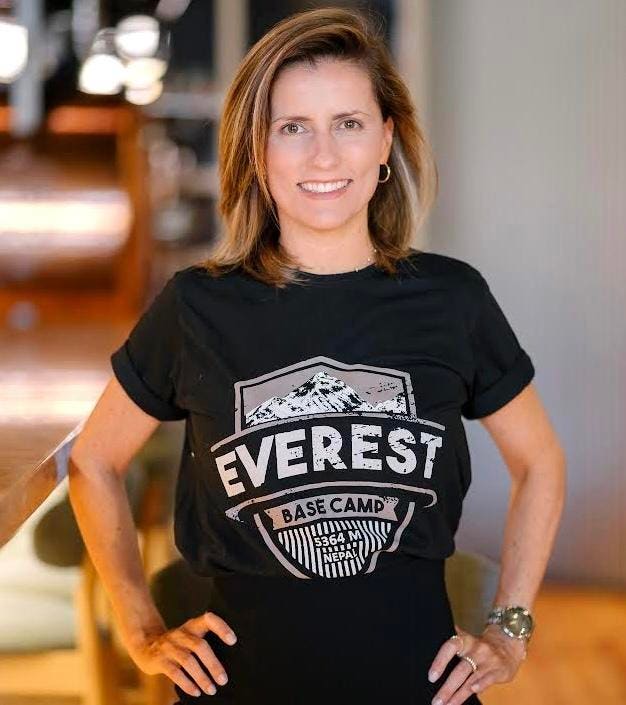Companies around the world spend millions of dollars a year on leadership development — and yet many of those selected to lead teams, departments or even whole organisations are still not fully qualified for the role. According to Teresa Carmo, who has held several strategic positions with world-leading corporations for nearly two decades and is currently on a leadership program at Stanford, this “leadership gap” is caused by what she calls “a vicious triangle.” This is comprised of a societal mindset that under-estimates the depth and meaning that leadership entails, organizations focusing on individuals’ functional abilities in the hiring process while failing to assess their holistic readiness for the role and leaders themselves not fully owning the building of their human capital.
With effective leadership arguably more important than it has ever been, Teresa believes all aspects of the triangle need addressing. But her own recent experience of taking part in a trek to the Everest Base camp demonstrates that for her the last is especially important. Arguing that leadership is one of the most important challenges of human-kind, she says that leaders have a bigger role to play individually by taking accountability for their own growth to rise to the occasion. “Leadership rises and falls in the ability to self-lead,” she says, adding that she believes that self-awareness is a key part of being a leader.
For her, the solution is not just for organizations to rethink and reformulate their expectations for leadership positions, but also for individuals to own their holistic development and elevate the quality of the pool of leaders available to perform the role. Part of this should involve acknowledging that there are limits to what a business setting can realistically do for human growth. Instead, leaders and would-be leaders may look for personal challenges outside of the office space, so that they are able to broaden and deepen their perspective. She argues that a level of discomfort should be a part of it, since that “forces people to face and evolve their human reality.”
Teresa has answered this desire to build her own human capital by embarking on several personal endeavours in the four corners of the world. The eight-day trek to the Everest Base Camp at 5,364 meters in the Himalayas is the most recent of these — and has had a profound effect on her thinking. “You cannot be what you cannot see,” she says, arguing that exploration beyond standardized paths is a key part of human growth. Several weeks after returning, she shares some of her key insights from Mount Everest, applicable to leadership.
1. An accelerator of awareness: All things big and small count more in high altitude. In survival mode, practically everything on the journey plays against the human capacity to finish the job, which is simply to get to the top. This gets trekkers in touch with the impact of details and how they build into the bigger goal, in a way we don’t get the chance to in normal life. In our day-to-day lives we can get away with disregarding the small things until they become bigger things. Not in high mountains. This is also true for our human reality. Not just strengths, as we may expect, but also weaknesses, are surfaced in a concentrated way, and need to be addressed one way or another. It’s a powerful show don’t tell exercise. Trekkers in that context can be challenged with harsh physical, emotional and mental discomfort. We are far from being at our best but have no choice but to show up if we are to make progress. We must get hold of ourselves in no time.
2. Neutralizing effect of social labels: Such a journey takes us back to our human condition. Either we find answers in it, or we may not find answers at all. Status, job titles or any other metric of success that we often tie our identities to like they were irrevocable are of no value there. The mountains make no judgement of any kind. That leaves us to humbly look into other perspectives of ourselves, knowing that far less than what we are used to is under our control — beyond the choice to persevere and how we do so. This necessarily broadens and deepens human capital, and deconstructs our self-image.
3. The importance of a shared-goal: It’s interesting to realize that the 8,000-meters climbers need a supporting team with them all the way to the top. Attempting to do it alone, or with a misaligned team, greatly increases the chances of death. It is not any different in leadership. In my journey to the 5,364-meters point I, too, could testify to the power of the group effect, which was a highlight to me. Despite the individual drive to do what everyone went there to do — get to the top— there was an atmosphere of genuine support amongst trekkers which had a multiplier effect of good energy. That emphasized the sense of a shared goal and added in ways I can’t begin to quantify to the meaningfulness of the experience.
She continues that, in her view, we might only scratch the surface of the theoretical understanding of these concepts in leadership and in life. The high mountains are ruthless in showcasing them effectively in an accelerated and concentrated way and in just a few days. For Teresa, the insights from her experience in Mount Everest, which had an accent on self-awareness, continue to evolve and be added to to this day. After long years in the corporate world, and a life spread across three continents and seven countries, she hasn’t come across a comparable tool with this power to change perspectives on self and on life. “There’s no return to the same point after such a journey,” she adds. While the experience was even tougher than she had imagined, she retains “exceptionally positive and unmatchable feelings” about it while having a greater respect for the here and now and an acceptance of “life as it is.” She believes that something does seem to shift in the brain after such an experience, whether that’s permanent or temporary she is yet to find out, though Mount Everest was to Teresa an incubator of what matters most in life. “The options on how to explore risks and discomfort out of the office space are personal and infinite,” she says. “They should, however, be normalized in the interests of the individual and collective rewards they can offer — and that includes creating more self-aware, purpose-driven and authentic leaders.”
Read the full article here









